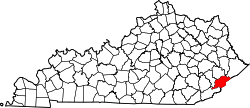Carbon Glow, Kentucky | |
|---|---|
| Coordinates: 37°10′47″N82°57′12″W / 37.17972°N 82.95333°W | |
| Country | United States |
| State | Kentucky |
| County | Letcher |
| Elevation | 1,293 ft (394 m) |
| Time zone | UTC-5 (Eastern (EST)) |
| • Summer (DST) | UTC-4 (EDT) |
| GNIS feature ID | 507649 [1] |
Carbon Glow is an unincorporated community located in Letcher County, Kentucky, United States.
The community was named for the Carbon Glow Coal Co. [2]


